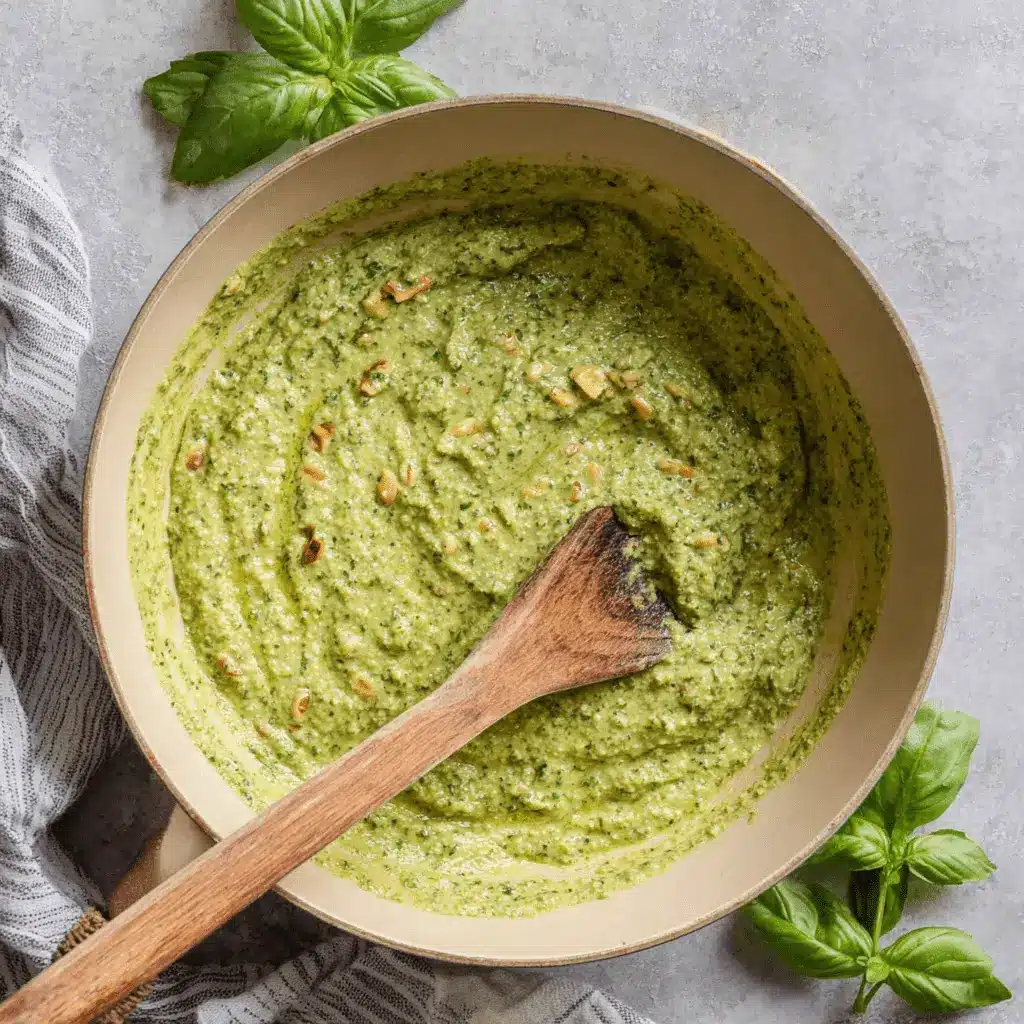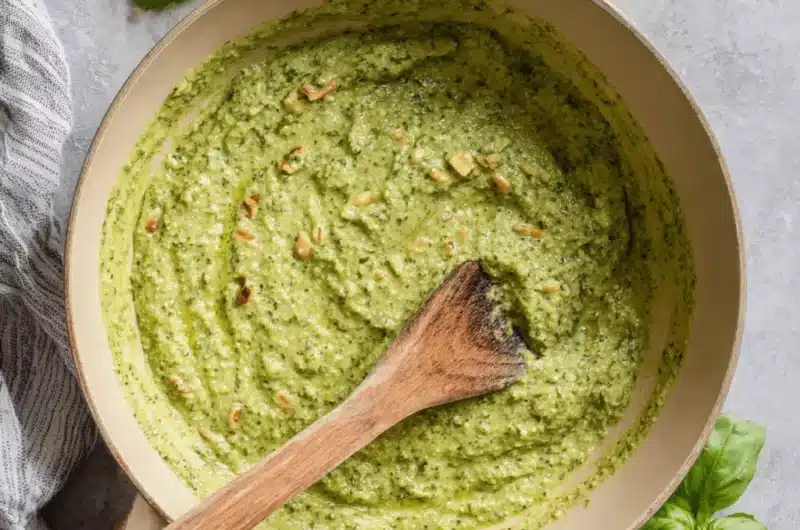Pesto sauce became my go-to after moving to the U.S., when I craved quick, comforting flavors that felt like home but didn’t require hours in the kitchen. This easy pesto sauce recipe takes just 15 minutes, and it’s perfect for turning any meal into something special without stress. It’s truly a game-changer for busy weeknights.
Table of Contents
Why This is the Ultimate Pesto Sauce Recipe (Our Promise)
- This guide is the ultimate, definitive resource to mastering homemade pesto, perfect for every cook and kitchen.
- I cover troubleshooting tips so you can fix common pesto problems with confidence.
- You’ll find different methods beyond the food processor, including blender and traditional mortar and pestle techniques.
- I include key pesto variations and storage advice to suit all diets and busy lifestyles.
The Secret to Great Pesto: A Deep Dive into Ingredients
Basil: Not All Greens Are Equal
Choosing the freshest and most vibrant basil is essential. Genovese basil, with its bright green leaves and aromatic flavor, is the star ingredient that defines a classic pesto sauce.
Olive Oil: The Key to Flavor and Texture
Use a high-quality extra virgin olive oil for the best flavor and smooth texture. A low-quality or bitter oil can ruin the sauce, so pick one that tastes fresh and fruity.
Nuts: Beyond Pine Nuts
While traditional pesto calls for pine nuts, using walnuts here offers a cost-effective, flavorful alternative. Plus, walnuts avoid the risk of “Pine Mouth Syndrome,” which some experience after eating pine nuts.
Cheese: The Umami Finish
Parmigiano-Reggiano adds a rich, savory depth to this pesto. Unlike Pecorino Romano, it brings a nuttier and more subtle umami flavor that balances the sauce perfectly.
Ingredients for Walnut Pesto Sauce
- ⅓ cup walnuts, toasted if desired (see note)
- 2 large garlic cloves, roughly chopped
- 2 cups packed fresh basil leaves
- ½ teaspoon salt
- ¼ teaspoon ground black pepper
- ⅔ cup extra virgin olive oil
- ½ cup grated Parmigiano-Reggiano
How to Make Pesto Sauce: Step-by-Step
- Chop nuts and garlic: Place walnuts and garlic in a food processor fitted with a steel blade. Process for about 10 seconds until coarsely chopped; the mixture should look like coarse sand.
- Add basil and seasoning: Add basil leaves, salt, and pepper. Process for about 1 minute until the mixture resembles a paste.
- Slowly add olive oil: With the processor running, slowly pour in the olive oil through the feed tube. Continue processing until pesto is thoroughly blended and slightly rustic in texture, not perfectly smooth.
- Blend in cheese: Add the Parmigiano-Reggiano and process for another minute to combine.
- Store properly: Use immediately or transfer to a tightly sealed jar or air-tight container. Cover with a thin layer of olive oil to prevent browning. Pesto will keep in the refrigerator for about a week.
Note: Toasting the walnuts brings out their flavor but is optional. To toast, preheat oven to 350°F. Arrange walnuts in a single layer on a baking sheet and bake for 6–8 minutes until fragrant, then cool on a plate.
Freezer-Friendly Tip
Pesto freezes beautifully for up to 6 months. Freeze in an airtight container or portion into ice cube trays. Once frozen, transfer cubes to a sealable bag. Use the thawed pesto cubes to effortlessly boost soups, pasta, eggs, sandwiches, or potatoes.
Don’t Have a Food Processor? No Problem!
Not having a food processor shouldn’t stop you from enjoying fresh pesto. Here are two easy alternatives.
Method 1: Making Pesto Sauce in a Blender
Add walnuts, garlic, basil, salt, and pepper to the blender. Pulse in short bursts to avoid overheating. Slowly pour in extra virgin olive oil while blending until you get a coarse, slightly chunky texture. Add grated Parmigiano-Reggiano last and pulse to combine.
Method 2: The Authentic Way with a Mortar and Pestle
Start by pulverizing the garlic and salt into a paste using the pestle. Add walnuts and grind until coarse. Gradually add basil leaves, crushing gently to release flavor without bruising. Slowly pour in olive oil while stirring to create a creamy, rustic texture. Finish by mixing in Parmigiano-Reggiano. This traditional method offers the most aromatic and textured pesto, perfect for all your homemade recipes.
Pesto Sauce Variations for Every Diet
| Variation Type | Ingredient Swaps | Pro Tip |
|---|---|---|
| Nut-Free Pesto | Replace ⅓ cup walnuts with ⅓ cup raw sunflower seeds or pepitas. | Toast seeds like nuts to deepen their flavor. |
| Vegan Pesto | Replace ½ cup Parmesan with 3 tbsp nutritional yeast + 1 tbsp white miso paste OR ¼ cup soaked cashews. | Nutritional yeast adds the cheesy note, while miso or cashews provide umami and creaminess. |
Storing and Freezing Your Homemade Pesto Sauce
How to Store Pesto in the Refrigerator
Always cover your pesto with a thin layer of olive oil before sealing. This seals out air and prevents oxidation that turns pesto brown. Stored this way, it lasts about a week in the fridge.
How to Freeze Pesto Sauce (The Best Way)
Freeze pesto in airtight containers for up to 6 months or in ice cube trays for portion control. For best flavor and texture, freeze pesto without the cheese and stir in freshly grated Parmigiano-Reggiano after thawing.
Creative Ways to Use Your Pesto Sauce
Pesto is incredibly versatile. Try these delicious ideas to bring fresh flavor to your meals:
- Toss it with pasta for an easy, vibrant dinner. Check out our Quick Pesto Pasta recipe for inspiration.
- Spread over grilled chicken breasts for a savory boost like in our 20-Minute Pesto Chicken.
- Add a smear to sandwiches or wraps for a flavorful punch.
- Swirl into scrambled eggs or omelets to start your morning with zest.
- Drizzle on homemade pizza for an herby twist.
- Stir into potato gnocchi to add richness and color.
- Mix into soups just before serving to brighten flavors, for example, our Amazing One-Pot White Lasagna Soup.

Pesto sauce
Ingredients
Equipment
Method
- In a food processor fitted with a steel blade, pulse walnuts and garlic until coarsely chopped, about 10 seconds.
- Add basil, salt, and pepper; process until a paste forms, about 1 minute.
- With the processor running, slowly stream in olive oil until emulsified and smooth.
- Add Parmesan and process about 1 minute more until thoroughly blended.
- Use immediately or store in an airtight container covered with a thin layer of olive oil; refrigerate up to 1 week.
- For freezing, pack in an airtight container or freeze in ice cube trays; store up to 6 months and thaw as needed.
- Optional: To toast walnuts, bake on a sheet at 350°F (175°C) until lightly toasted and fragrant, 6–8 minutes; cool before using.
Notes
Pesto Troubleshooting: A FAQ Guide
Why did my pesto turn brown or black?
Pesto browns due to oxidation when exposed to air. The quick fix is to cover it with a thin layer of olive oil. For an advanced solution, blanch basil leaves briefly in boiling water before processing to preserve their vibrant green.
Why does my pesto taste bitter?
Bitterness usually comes from low-quality olive oil, over-processing the basil leaves, or using a particular variety of walnuts. Use fresh, fruity olive oil, pulse gently to avoid bruising basil, and try toasting walnuts to mellow their flavor.
How can I fix pesto that is too oily or too thick?
If pesto is too oily, stir well or add more basil and nuts to balance it out. For a thick pesto, drizzle in more olive oil or add a splash of pasta water if serving immediately, until you reach the right consistency.
Conclusion
Making homemade pesto sauce is easier than you think, and so rewarding. Its quick prep, rich flavors, and versatility make it a kitchen staple you’ll turn to again and again. We’ve shown you how to make pesto with a food processor and a mortar & pestle. Which method are you going to try first, and what will you serve it with? Let me know in the comments below!









